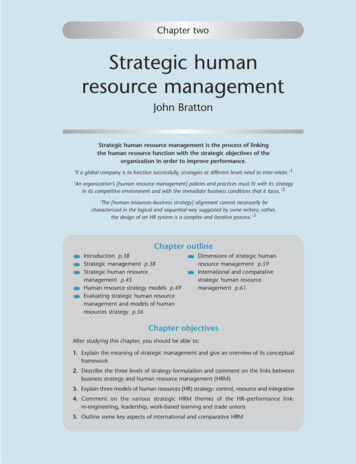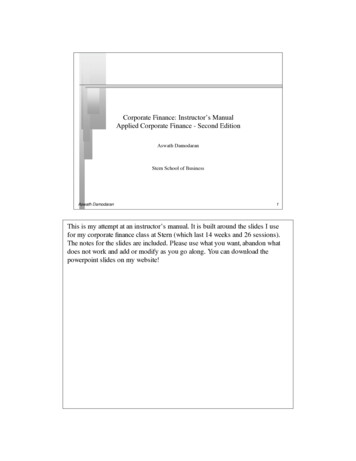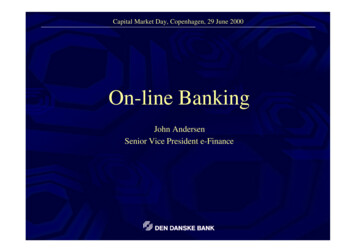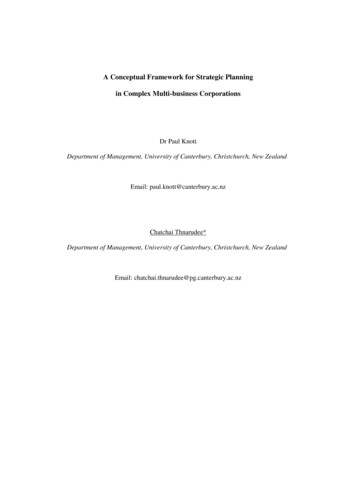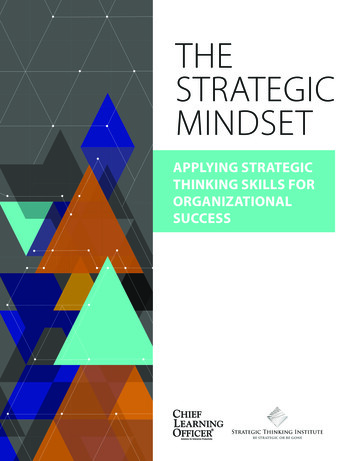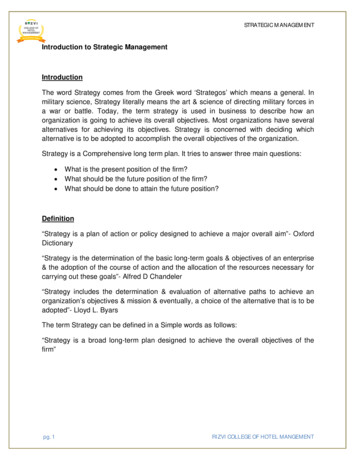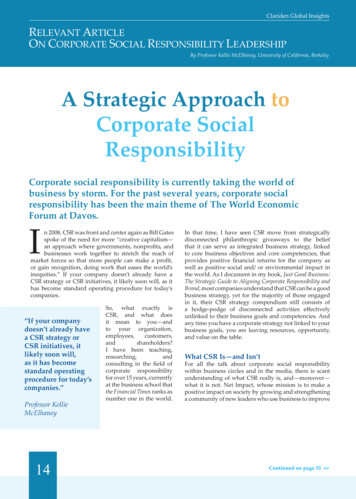
Transcription
Clariden Global InsightsRELEVANT ARTICLEON CORPORATE SOCIAL RESPONSIBILITY LEADERSHIPBy Professor Kellie McElhaney, University of California, BerkeleyA Strategic Approach toCorporate SocialResponsibilityCorporate social responsibility is currently taking the world ofbusiness by storm. For the past several years, corporate socialresponsibility has been the main theme of The World EconomicForum at Davos.In 2008, CSR was front and center again as Bill Gatesspoke of the need for more “creative capitalism—an approach where governments, nonprofits, andbusinesses work together to stretch the reach ofmarket forces so that more people can make a profit,or gain recognition, doing work that eases the world’sinequities.” If your company doesn’t already have aCSR strategy or CSR initiatives, it likely soon will, as ithas become standard operating procedure for today’scompanies.“If your companydoesn’t already havea CSR strategy orCSR initiatives, itlikely soon will,as it has becomestandard operatingprocedure for today’scompanies.”Professor KellieMcElhaney14So, what exactly isCSR, and what doesit mean to you—andto your organization,employees,customers,andshareholders?I have been teaching,researching,andconsulting in the field ofcorporate responsibilityfor over 15 years, currentlyat the business school thatthe Financial Times ranks asnumber one in the world.In that time, I have seen CSR move from strategicallydisconnected philanthropic giveaways to the beliefthat it can serve as integrated business strategy, linkedto core business objectives and core competencies, thatprovides positive financial returns for the company aswell as positive social and/ or environmental impact inthe world. As I document in my book, Just Good Business:The Strategic Guide to Aligning Corporate Responsibility andBrand, most companies understand that CSR can be a goodbusiness strategy, yet for the majority of those engagedin it, their CSR strategy compendium still consists ofa hodge-podge of disconnected activities effectivelyunlinked to their business goals and competencies. Andany time you have a corporate strategy not linked to yourbusiness goals, you are leaving resources, opportunity,and value on the table.What CSR Is—and Isn’tFor all the talk about corporate social responsibilitywithin business circles and in the media, there is scantunderstanding of what CSR really is, and—moreover—what it is not. Net Impact, whose mission is to make apositive impact on society by growing and strengtheninga community of new leaders who use business to improveContinued on page 35
Clariden Global InsightsRELEVANT ARTICLEON CORPORATE SOCIALRESPONSIBILITY LEADERSHIPKellie A. McElhaney is the Margo N. Alexander FacultyFellow in Corporate Responsibility and the foundingFaculty Director of the Center for Responsible Businessat the University of California, Berkeley.A Strategic Approach toCorporate Social Responsibility Continued from page 14the world, defines CSR simply as using the power ofbusiness to create a better world. In my own work, Ithink of CSR in terms of corporate strategy, and advocatethat firms use CSR as part of their portfolio of businessstrategies. I therefore developed and use the followingdefinition of strategic corporate social responsibility:employees are significantly interested in, more highlysatisfied with, and more loyal to companies that havea proven commitment to corporate responsibility. Asa result, CSR can be used as an effective strategy torecruit and retain top talent, which has obvious positiveimplications for the bottom line.A business strategy that is integrated with core businessobjectives and core competencies of the firm, and from theoutset is designed to create business value and positive socialchange, and is embedded in day-to-day business culture andoperations.The IBM Institute for Business Value recently surveyeda group of 250 business leaders worldwide, findingthat more than two-thirds (68 percent) are focusingon corporate social responsibility activities to createnew revenue streams. In addition, more than half (54percent) of the surveyed business leaders believe thattheir companies’ CSR activities are already giving theman advantage over their top competitors. According toIBM’s report on these findings, “When aligned withbusiness objectives, companies are beginning to see thatCSR can bring competitive differentiation, permissionto enter new markets, and favorable positioning in thetalent wars.”One common problem in defining CSR within a companyis that the concept of corporate social responsibility itselfgoes by many different names. What is called “corporatesocial responsibility” in one organization might be giventhe label “spiritual capitalism” in another. During myvast work in this area, I have encountered a varietyof other terms for CSR in organizations, includingcorporate responsibility, sustainable development,global citizenship, corporate citizenship, values-drivenbusiness, natural capitalism, spiritual capitalism, andmany more.Regardless of the label used, I personally try to dissuadeleaders from wasting a lot of time splitting hairs overa name for their own CSR efforts. I instead stronglysuggest that they indeed call it something, give it a nameand use it consistently, and define it for themselves asa company. Many companies stop there and that isnot enough. The more critical step is that they developand execute a business strategy around their CSR,communicate it, and brand it.The Value of CSRThe most researched and proven financial benefitsof effective strategic CSR can be found in the areas ofhuman resources and talent management, reputationand branding, and operational cost savings. It’s clearProven financial benefitsof CSR can be found in theareas of human resources,reputation and branding, andoperational cost savings.Consider this example from retail giant Wal-Mart. Afterreceiving company-provided training on sustainability,Darrell Meyers—an employee in a North Carolina WalMart store—submitted a suggestion to remove lightbulbs from store vending machines. This seems likean inconsequential action—at least until you multiplyits impact throughout a large organization. Vendingmachine lights stay lit 24/7—constantly consuminga steady stream of electricity—and they periodically35
RELEVANT ARTICLEON CORPORATE SOCIAL RESPONSIBILITY LEADERSHIPneed to be replaced by maintenance workers. Not onlywould Darrell’s idea be good for the earth (by reducingenergy consumption), it would save the company money,reducing its costs. As it turned out, Darrell’s suggestionpromised to save Wal-Mart more than 1 million a year,and it was quickly implemented.Creating a CSR StrategyManagement guru Peter Drucker perhaps said it best:“What gets planned gets done.” Leaders have longknown that to achieve their company’s goals, they needstrategies that get everyone in the organization headedin the right direction at the right time, and that ensurethat resources are mobilized where required. Consider,for example, a typical corporate strategy—in this case,Hewlett-Packard’s (HP) 2006 strategy to “Establish HP asthe world’s leading information technology company.”Hewlett-Packard’s goal is both clear and inspirationalThe higher CSR reports, themore closely linked it is toproviding value.to the company’s employees. And just as clear are thethree, interdependent strategies that HP established forachieving this goal: targeted growth, capital strategy,and efficiency. If you are an HP employee, you know thatif you contribute to one or more of these three strategies,you are helping the company achieve its greater goalof information technology supremacy. More so, as anemployee, you know that every year, your performancewill be measured on your success in contributing to oneor more of these strategies.Unfortunately, few CSR strategies are as clear andcompelling as HP’s corporate strategy. Because the actualgoals for most CSR efforts aren’t in support of typicalcorporate functions such as marketing, manufacturing,sales, and so forth, many companies aren’t exactlycertain of what goals to set for them, or what strategies to36pursue. The result is often a hodgepodge of unfocused,unlinked, and unrelated strategies in search of anoverarching goal.When leaders work with their people to craft a CSRstrategy for their companies, they should at minimumpursue the following course of action:Senior leadership and management of the firm, including theboard, must make an authentic, firm, and public commitmentto CSR, and engage in it.In many organizations, CSR is born organically, withinlower levels of employees. But, for such CSR initiativesto have legs, senior executives must be brought onboard, they must commit to it, and engage in it. A clearvision of CSR needs to be embedded within and reflectthe core values of the firm, and be linked to the mission,vision and values of the organization—recognizing thatit creates not only social or environmental value, but thatit creates business value as well. CSR can and should betreated and managed as a core business strategy just asare the strategies of marketing, research & development,capital expenditures, and talent management. CSRshould report to a top-level leader in the company, asopposed to being side-lined in the corporate foundation.The board of the company should be engaged aswell, and be responsible for the CSR strategy just asthey have responsibility for other business strategieslike accounting, finance and marketing. Innovativecompanies like Timberland have board committeesoverseeing corporate responsibility, and Gap takesboard members on factory tours in China so they cansee the value of supplier codes of conduct and audits.Generally the higher up CSR reports in the company, themore closely linked to providing value it is as a strategy.Determine the top-three business objectives andpriorities of the company, and develop a CSR strategythat will contribute to the achievement of those businessobjectives.When developing a CSR strategy, the company’s leadersmust first determine what specific business objectivesthis strategy must support. Defining business objectivesis not as easy as it might appear at first glance. Askany group of business managers within a company todescribe their business objectives and priorities, andyou’re likely to get different answers from each. I once
Clariden Global Insightsconsulted with a tech company in Silicon Valley whosetop executive quickly answered the top-three businessobjectives question with this response: “Growth, growth,and growth.” However, her Human Resources Directorlooked quite pained in responding that until theywere able to triage the company’s 82-percent turnoverrate, they were going to have a difficult time growing,growing, growing.CSR can certainly be used as a talent attraction andretention strategy if it is communicated clearly topotential and current employees, and they can engagein it. A conversation needs to occur at a deeper levelso that the CSR strategy can serve to provide for thesegeneral objectives. Is it growth in new markets, and ifso, which ones? CSR can be used as a strategy to open upnew markets for energy-efficient products, for example.Is it penetrating new customer segments or grabbingmarket share from competitors, and if so, which marketsegments? CSR can be used to grab market share fromcompetitors if communicated effectively to customerswho care about environmentally-friendly product lines.Align CSR strategy with the firm’s core competencies.CSR in most businesses is typically executed in a veryad hoc, non-integrated fashion. CSR initiatives originatefrom all parts of an organization, and are often notdirectly linked to what the firm actually knows, does,or is expert in. Firms should, however, seek causes andsocial/ environmental strategies for which they ownpart of the solution. This requires focus and disciplineand sticking true to that you know despite the myriadworthy causes and issues in our world.Consider the of Ford Motor Company Foundation’ssupport for breast cancer research—in the amountof 100,000 each year to the Susan G. Komen BreastCancer Research Fund. There is no argument that thisis a worthy cause with significant need, but there is nostrategic link between the company’s support for breastcancer research and the building of cars and trucks.Automotive companies know cars, transportationengineering, and design. It makes far more sense for anautomobile manufacturer like Ford to support research inalternatively-fueled vehicles or to address the global andenvironmental challenges around gasoline dependencybecause these initiatives fit the firm’s core competenciesand business objectives of selling more cars whilepotentially creating new products and revenue streams.Fully integrate CSR into the culture, governance and strategydevelopment of the company, and into existing managementand performance systems.CSR can be both a risk mitigation strategy and anopportunity-seeking strategy, and leaders should look forthe “sweet spot” within their organizations—that is, theintersection between business and social/ environmentalThere is no strategic linkbetween Ford’s support forbreast cancer research and thebuilding of cars and trucks.returns. CSR will not be fully embraced and executedwith as much precision as are the more commonlymeasured functions such as sales and staff managementuntil it is built into the recognition and performanceappraisal system for a company’s employees. Johnsonand Johnson measures its employees on both theirfunctional job performance as well as their performanceon J & J’s infamous ethical credo. Walmart, whenselecting suppliers, indexes them on price, quality, instock statistics, and sustainability scores. Sustainabilityis integrated in to their internal buying processes.Develop clear performance metrics, or key performanceindicators, to measure the impact of their CSR strategies.CSR performance metrics should be both internal—suchas reputation improvements, gains in market share,brand perception, increased sales, decreased operationalexpenditures, and employee satisfaction—as well asexternal ones focused on society and the environment.If there are no performance metrics in place, there willbe no way to prove that the strategy was effective, whichmeans that the strategy will not be sustainable over thelong haul.Consider the example of General Electric, whichlaunched its Ecomagination program in 2006 with the37
RELEVANT ARTICLEON CORPORATE SOCIAL RESPONSIBILITY LEADERSHIPview that it would become a value-creating strategy forthe firm:Ecomagination puts into practice GE’s belief that financialand environmental performance can work together to drivecompany growth, while taking on some of the worlds biggestchallenges. the GE commitment to products and servicesthat are as economically advantageous as they are ecologicallysound.GE views CSR as part of its business strategy—to sellmore goods and services and create value for the firm—and its approach meets my own definition of CSR asit also exists to create positive environmental value byfocusing on increasing energy efficiency. Ideally, as anincreasing number of companies begin to view CSRas a business strategy—and succeed in creating value,including increased sales, new market entrance, andbrand differentiation—their competitors will follow suitand even collaborate, raising the entire civil, standards,and rules of the gameBranding and Communicating Your CSRI can’t count how many times I’ve heard corporateexecutives—everyone from CEOs to VPs of corporatecommunications to brand managers to directors ofcorporate responsibility—list the myriad reasons,risks and fears for not publicly communicatingtheir company’s work in the area of corporate socialresponsibility. Convincing these gun-shy corporateleaders to tell their CSR story can be a real and ongoingchallenge. The problem is, you cannot not communicate.Few business leaders embrace the value in communicatingand branding their CSR substance and continue to fail tocommunicate, this suggesting that they do nothing in thearea of CSR. Companies expend millions on brandingand messaging its reputation, products and services,but do not link the ways in which their products andservices contribute to a better world, such as HP’s deepand long-term commitment to recycling. Dell comesalong with a printer for which when purchased, thecompany plants a number of trees, they communicatethis clearly to consumers, and suddenly Dell becomesknown as an environmentally friendly company to HPsloss. A consumer cannot factor in to his or her decisionmaking that which they do not know.This is a significant lost opportunity.38Branding a firm’s CSR content, once it is truly developed,executed, and integrated into the organization, can bean innovative and valuable business strategy to reachmultiple critical constituencies—employees, suppliers,business partners, investors, peers and consumers—inside and outside of the corporation. Like anything elsein business, to be effective, it has to be done right. LeviStrauss has always promoted employee volunteerisminternally, and this has done wonders for employeesatisfaction, engagement, and retention. But for the firsttime that I’ve ever seen something like this happen, Levilaunched a campaign to get their customers involvedin volunteering within their communities. Levi StraussConvincing gun-shycorporate leaders to telltheir CSR story can be areal challenge.has named May 1st 501 Day—a day designated by thecompany for employees from Levi Strauss & Companyheadquarters, offices, and stores across the countryto volunteer with community-based nonprofits.VolunteerMatch set up a Web-based platform where youcan log onto Levi.com, enter your zip code, and find allthe various volunteer opportunities in your area whereyou could go out and work alongside Levi volunteeremployees.This approach is particularly effective because Levi isn’tjust telling and showing consumers what they do, butare instead saying “Do it with us.” VolunteerMatch isthe quintessential website for matching volunteers withopportunities, and they have set up many corporateplatforms—providing the horsepower behind manycorporate volunteer sites. Simply enter your zipcode and interests—environmental, women, youth,education—and specify when you are available to work,weekends, evenings, or during the day. The system willimmediately provide you with listings of opportunitiesbased on what you input.
Clariden Global InsightsConsumers today are looking for a relationship, notjust a transaction. CSR can be an effective way to buildrelationships because it’s hard to build a relationshipjust around the act of buying a pair of jeans—or anyother product. You’re probably already in the habit ofmanaging your messaging, and hence your reputation,strategically and consistently, and spending a greatdeal of money doing so. Think of CSR as anothercomponent of this strategic communication andmessaging management. Perhaps it can even be oneof its most important components. Particularly withCSR communication and branding, consistency is key.Once you have engaged deeply with all stakeholdergroups and have selected the appropriately fittingcauses and opportunities, constantly and consistentlycommunicating a simple strategic message will addvalue. This means integrating your CSR message withyour core branding strategy externally to consumers,of course, but this also means communicating a clearConsumer wants arelationship,not just a transaction.consistent message internally to employees, andexternally to potential employees, suppliers, retailers,governments, communities, and peers.Moving ForwardIf you are serious about helping to drive a CSR strategythrough your own business, then you should be acutelyaware of where global corporate social responsibility isheaded in the future. CSR trend analysis suggests that: Consumers are increasingly interested in takingaction on issues such as climate change.CSR/branding campaigns that resonate withconsumers are those that address the consumer’sinterest, provide easy-to-digest education, andspark dialogue and action.Reputable campaigns are those that are innovative and substantiated by the company’s authenticcommitment and ability to demonstrate tangibleresults towards their CSR goals.Partnerships are critical as a pathway forward,either between companies or with NGO partners.They help build credibility, and no one companycan go it alone against an issue as large as globalwarming or AIDS.CSR is not going away any time soon. The Millennialgeneration, which is now hitting the workforce, isdemanding and driving this reality.Your competitors are developing CSR strategies.Don’t let them get ahead of you because it is difficultto catch up once you get behind. CSR does nottend to show quarterly results—it is a longer-termventure.In the future, the focus will not be on whether or notto engage in CSR, but how to do it smarter, morestrategically, and to integrate it into companies’ day-today business strategies. The focus will also be on howbest to communicate and brand your CSR. Althoughstill relatively young, the CSR space is getting crowded.However, the space of smart, effective, strategic CSRis less crowded, and the space of well-branded, wellcommunicated CSR is wide open, so grab the leadershipspot for your industry now. And remember that CSRbrands hope. And if there’s one thing we can all agreeon, it’s that the world today is suffering from a universallack of hope.Dr. Kellie A. McElhaney is the Margo N.Alexander Faculty Fellow in CorporateResponsibility and the founding FacultyDirector of the Center for ResponsibleBusiness at the Haas School of Business atthe University of California, Berkeley. Shelaunched this new center in 2003, whichhas helped place corporate responsibilitysquarely as one of the core competencies andcompetitive advantages of the Haas School.Professor McElhaney is also author of thebook Just Good Business: The Strategic Guideto Aligning Corporate Responsibility andBrand (Berrett-Koehler, 2008).39
C LARI D E N G LO BALGLOBAL EXECUTIVE EDUCATION“where the best minds meet” TM2010 Clariden Global Executive EducationCorporate Social Responsibility ProgramCorporate Social ResponsibilityLeadershipProfessor Kellie A. McElhaneyUniversity of California, Berkeley, Haas School of BusinessDr. Kellie McElhaney is the Margo N. Alexander Faculty Fellow in Corporate Responsibility and the foundingFaculty Director of the Center for Responsible Business at the Haas School of Business at the Universityof California, Berkeley. She founded this center in 2003, which has helped place corporate responsibilitysquarely as one of the core competencies and competitive advantages of the Haas School. In her five yearsat Haas, her Center has received global critical acclaim. The Wall Street Journal ranked Haas as the numbertwo business school in the country for CSR in 2006 and 2007. The Financial Times rated Haas number one inthe world in January 2008.Professor McElhaney teaches courses on Strategic Corporate Social Responsibility, which include indepth, experiential consulting engagements with companies on real-world, high-visibility strategic CSRchallenges, in all of the MBA degree programs at Haas and extensive Executive Education in this area.Kellie was named a Faculty Pioneer by the Aspen Institute in 2005.In addition to her University activities, Kellie consults to several Global 1000 companies in developingintegrated CSR strategy, bridging her academic focus with the practitioner world. Her client list includesHP, Gap, eBay, McDonalds, Ernst & Young, NVIDIA, Blue Cross Blue Shield, Nokia (Finland), Navigant,Volunteer Match, Ford Motor Company, Bernard Hodes Group (Great Britain), PG&E, Driscolls Berries,Triage Consulting Group, Ulster Bank (Ireland), StatoilHydro (Norway) and PG&E. After helping morethan 150 companies develop CSR strategies, Kellie encapsulated her advice in her book Just Good Business:The Strategic Guide to Aligning Corporate Responsibility and Brand.Kellie serves on the Board for Foundation Île à Vache, which she helped to found with a group of Irish CEOsin June of 2007. It supports infrastructural and economic development on this island in southern Haiti. Sheis also on the management team of the Encircle Foundation, which fosters corporate sector support of theMillennium Development Goals by launching enterprise solutions to poverty, and serves on the boards ofNet Impact and VolunteerMatch.11
CORPORATE SOCIAL RESPONSIBILITY PROGRAMCORPORATE SOCIAL RESPONSIBILITY LEADERSHIPProfessor Kellie A. McElhaney, University of California, Berkeley, Haas School of BusinessMargo N. Alexander Faculty Fellow and Founding Faculty Director of Center for Responsible BusinessDr. Kellie McElhaney is Alexander Faculty Fellow and the founding Faculty Director of theCenter for Responsible Business at University of California, Berkeley. She founded thiscenter in 2003, which has helped place corporate responsibility squarely as one of the corecompetencies and competitive advantages of Haas. In her five years at Haas, her Center hasreceived global critical acclaim. The Wall Street Journal ranked Haas as the number two businessschool in the country for CSR in 2006 and 2007. The Financial Times rated Haas number one inthe world in January 2008. Kellie was named a Faculty Pioneer by the Aspen Institute in 2005.After helping more than 150 companies develop CSR strategies, Kellie encapsulated her advice in her book Just GoodBusiness: The Strategic Guide to Aligning Corporate Responsibility and Brand. Kellie consults to several Global 1000companies, including HP, Gap, eBay, McDonalds, Ernst & Young, NVIDIA, Blue Cross Blue Shield, Nokia, Navigant,Volunteer Match, Ford Motor Company, PG&E, Triage Consulting Group, Ulster Bank, and StatoilHydro.PRO G RAM S U M MARYProgram:Dates:Location:Corporate Social Responsibility LeadershipTuition Fee: S 3,25011th—12th November, 2010Register before 16th August for Early Bird Fee: S 2,950The Sentosa Resort and Spa Hotel, SingaporeProgram Essence: The starting point of this program is that despite the growing number of CSR success stories,companies continue to struggle with the fundamental challenges of embedding CSR into dayto-day business strategy to maximize business impact. This hands-on program is designed tostrengthen Board of Directors, C-Level and Senior-level executives’ efforts to integrate corporate social responsibility into their business strategy. This program’s practical outlook will helpparticipants develop insights to build an effective CSR business strategy, connect brand withCSR, communicate CSR, and develop metrics to measure and maximize business impact.PRO G RAM I N T RO D U C T I O NWith today’s global economic challenges, corporate social responsibility (CSR) is about businessinnovation, brand differentiation, attracting and retaining top talent, operational efficiencies, andcreating competitive advantage – a critical strategy for leading companies. Despite the growingnumber of CSR success stories, companies continue to struggle with the fundamental challengesof embedding CSR into day-to-day business strategy to maximize business impact.Corporate social responsibility is most effective when it is intimately connected to the corporatebrand and strategy - reinforcing a company’s unique identity and playing an integral part of howit tells its story. To help business leaders tackle these challenges, this two-day leadership programis designed to strengthen a company’s efforts to integrate corporate responsibility into businessstrategy.WHO WILL BENEFIT MOSTThis course is designed for: Board of Directors C-Level executives Senior level executives in charge of CSR/Business Sustainability Functional executives with P&L responsibilities12For complete information on admission, visit: www.claridenglobal.org
Clariden Global Executive EducationHOW YOU WILL BENEFITParticipants will develop the insight to analyze, build, and refine an effective CSR businessstrategy in a hands-on, highly interactive program. You will learn from leading practices of globalmultinational corporations as well as small to mid-sized enterprises.Key concepts addressed and tools employed:Integrating and aligning corporateresponsibility inside of companies with: Core business objectives Core competencies Mainstream business functions Leadership, vision, mission and values Branding and reputation Reporting and communications Financial impact Social or environmental value creation Trends in global CSRDuring the program, participants will: Understand the broad and varied conceptsin this field Learn from current-case best practices ofCSR across sectors Think about the business drivers for CSR Think creatively about relevant CSRstrategy for your company Assess their own company’s level ofstrategic CSR Begin to develop integrated CSR withintheir own companiesPRO G RAM O U T LI N EHIGHLIGHTED SESSIONSOverview of CSR, Global Trends & Leading ExamplesDiscuss the current state of corporate social responsibility (CSR) – what it is, why companies shouldintegrate it into their business strategies, and why they should do it now. Explore how to developeffective CSR strategies; how to align them with your company’s core objectives, competencies, andstakeholder expectations; and how to maximize CSR value within the firm.CSR as Core Business Strategy: The “C” in CSRLearn how to link CSR to your core business objectives – increase sales, penetrate new markets,engage employees, reduce operating expenses, improve reputation, beat competitors – and leverageyour core competencies to create business value & positive social change.Communicating and Branding CSRExplore the power of branding CSR efforts by communicating to customers, vendors, shareholders,and other stakeholders – closely linking efforts to products and service
definition of strategic corporate social responsibility: A business strategy that is integrated with core business objectives and core competencies of the firm, and from the outset is designed to create business value and positive social change, and i



